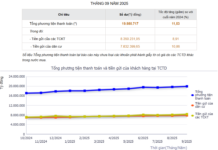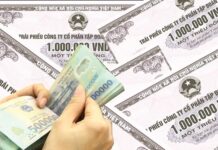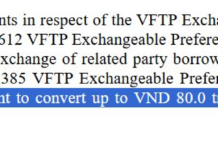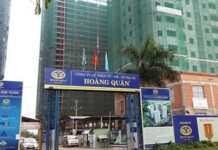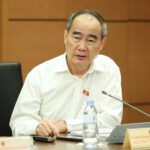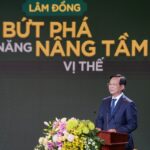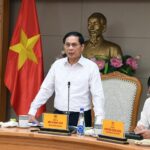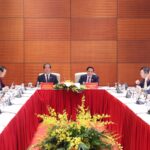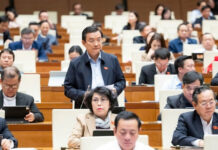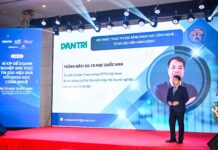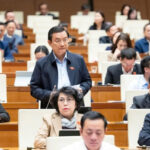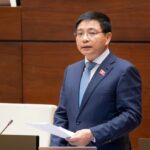At the First Congress of the Government Party Committee for the 2025-2030 term, Deputy Prime Minister Nguyen Hoa Binh, a Politburo member and Permanent Deputy Secretary of the Party Committee, presented the political report of the Government Party Committee’s Executive Board for the 2020-2025 term to the Congress.
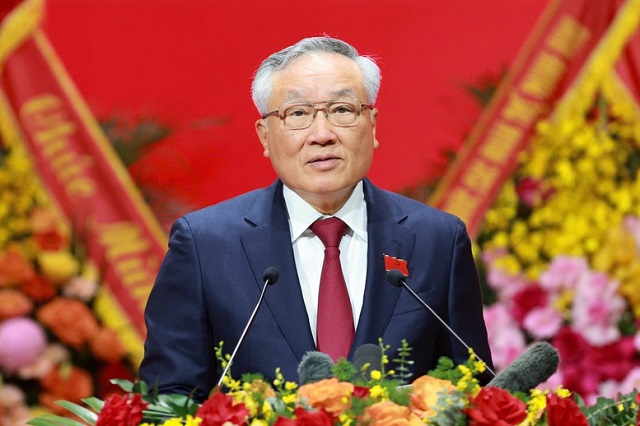
Politburo member, Permanent Deputy Secretary of the Party Committee, and Deputy Prime Minister Nguyen Hoa Binh presented the political report of the Government Party Committee’s Executive Board for the 2020-2025 term – Photo: VGP/Nhat Bac
|
Reporting on the results of task implementation for the 2020-2025 term, Deputy Prime Minister Nguyen Hoa Binh stated that under the leadership of the Party Central Committee, the Politburo, and the Secretariat, headed by the General Secretary, the Government Party Committee has adhered to the Party’s leadership principles and methods. With determination and resilience, it has focused on leading and directing the successful implementation of the Party’s policies and guidelines, achieving significant and comprehensive results with many outstanding highlights.
Party Building and Rectification Receive Special Attention
Specifically, Party building in terms of politics, ideology, and ethics has been strengthened with many innovations. The study and implementation of resolutions, directives, conclusions, and regulations from the Central Committee have been seriously organized and implemented by the Government Party Committee, with focused content and diverse forms, ensuring 100% of party members fully study and implement them.
Political theory education and the fight to protect the Party’s ideological foundation have been systematically and effectively implemented. Mass mobilization and leadership of socio-political organizations have been innovated by party committees and organizations, focusing on grassroots levels, especially mass mobilization in government agencies. Socio-political organizations have successfully organized their term congresses, directed the completion of organizational structures, developed operating regulations, work programs, and coordinated efforts to care for the material and spiritual lives of union members, association members, and workers.
Party organization and rectification have received special attention, with comprehensive and synchronized implementation, becoming one of the strategic breakthroughs of the Party Committee. This includes continuing to implement the 11th and 12th Central Resolutions. The quality of party organizations and members has been improved, and personnel work and management have been renewed in accordance with regulations. The Government Party Committee has focused on leading and directing the strict implementation of Resolution No. 18-NQ/TW and other Central and Politburo resolutions and conclusions on streamlining the political system’s apparatus for efficiency and effectiveness. It has promptly guided the implementation of policies on reorganizing the apparatus, merging, consolidating, transferring, and receiving party organizations and members.
Immediately after the Government Party Committee was established, it urgently and decisively led the organization and implementation of a “revolution” in streamlining and completing the apparatus, with breakthrough methods, making the internal organization more streamlined and implementing a two-tier local government model. This ensures synchronization, smoothness, and efficiency, along with promoting decentralization and empowerment, gradually shifting from a managerial administration to a service-oriented one for the people.
After streamlining, the government reduced 5 ministries and 3 ministry-level agencies (to 17 ministries and ministry-level agencies, and 5 government-attached agencies); eliminated all 30 general departments, 4,118 departments, sub-departments, and equivalents, and 240 ministry-affiliated public service units; and completed the two-tier local government organization. Through apparatus streamlining, 145,000 payroll positions were reduced, saving VND 39,000 billion annually for social security investment.
Inspection and supervision have been strengthened, focusing on fighting corruption, waste, and negativity. Inspections have targeted key areas, and supervision has been expanded. The quality and effectiveness of inspection and supervision have improved, significantly contributing to Party building and rectification and the political system.
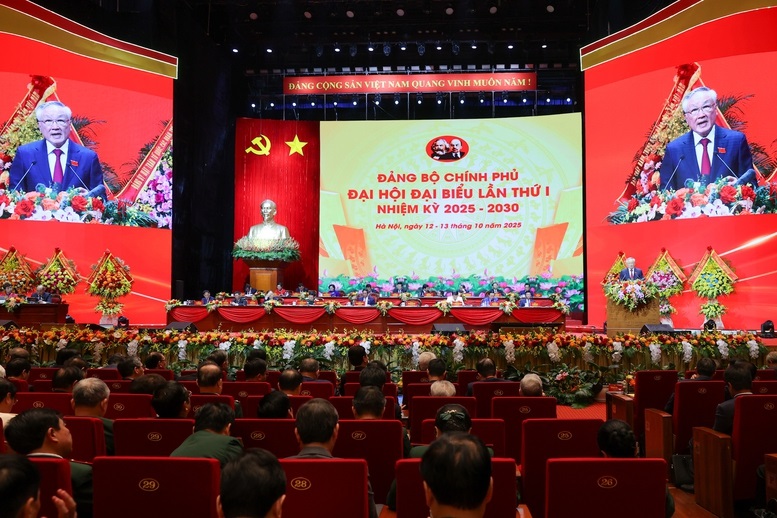
The Government Party Committee aims to comprehensively and effectively lead the implementation of three strategic breakthroughs: perfecting comprehensive institutions, building synchronized economic infrastructure, and developing high-quality human resources – Photo: VGP/Nhat Bac
|
Leading and Directing the Completion of Socio-Economic Development Goals for 2021-2025
In a context of more challenges than opportunities, the Government Party Committee has led and directed the completion of socio-economic development goals for 2021-2025, with results improving year by year. It achieved and exceeded 24 out of 26 targets, especially completing all social targets.
Notably, it led the implementation of solutions to promote economic growth. Macroeconomics remained stable, inflation was controlled, and major balances were ensured. Public debt and state budget deficits were well-controlled, staying well below permitted limits.
GDP increased from USD 346 billion in 2020, ranking 37th globally, to over USD 510 billion in 2025, rising 5 places to 32nd globally and 4th in ASEAN. Per capita GDP increased 1.4 times, from USD 3,552 to over USD 5,000, entering the upper-middle-income group.
State budget revenue for 2021-2025 is estimated at VND 9,600 trillion, 1.36 times higher than the 2016-2020 period and exceeding the target (VND 8,300 trillion, up over 15.6%). Trade scale increased annually, reaching a record of about USD 850 billion in 2025, placing Vietnam among the top 20 global trading nations, with a large trade surplus maintained.
Resources for development investment were mobilized and used more effectively. Total social investment reached VND 17,300 trillion, or 33.2% of GDP, meeting the target (32%-34%). Public investment reached VND 3,400 trillion, up 55% from the previous term, overcoming scattered public investment and ensuring focus and efficiency. FDI quality continued to improve.
Enterprise development remained positive. International organizations positively assessed Vietnam’s leadership and management, development results, and prospects.
Leading the implementation of three strategic breakthroughs achieved many outstanding results. Thinking and methods for building and enforcing laws were innovated, and decentralization and empowerment were promoted. The Government Party Committee addressed bottlenecks and mobilized resources for development, proposing important projects to the Politburo, which issued many breakthrough resolutions. It submitted to the National Assembly the largest number of laws and resolutions in a term (88 laws and 37 resolutions).
Investment in infrastructure, especially expressway traffic, airports, seaports, urban railways, and digital infrastructure, opened new development spaces. By the end of 2025, Vietnam will have completed 3,200 km of expressways (exceeding the 3,000 km target) and 1,700 km of coastal roads (meeting the target). It will also complete the Long Thanh International Airport and key infrastructure, information technology, and energy projects.
Many lingering projects, long-loss-making enterprises, 5 weak credit institutions, and 12 loss-making projects from previous terms were decisively handled with positive results. Localities were directed to resolve bottlenecks, putting 1,154 projects and land facilities worth about VND 675 trillion into operation and investment. They are reviewing, classifying, and proposing solutions for nearly 3,000 projects with capital in the trillions and land use in the hundreds of thousands of hectares.
Human resource development and comprehensive education reform achieved positive results, with the trained labor rate increasing from 64.5% in 2020 to 70% in 2025. Science, technology, innovation, and digital transformation were prioritized, with the establishment of a national data center and the application of resident data, identification, and electronic authentication, laying the foundation for digital government, economy, and society.
Cultural development, social progress, equity, and social security showed clear improvements, with people’s lives continuing to improve.
Policies on ethnicity, religion, beliefs, care for the elderly, child protection, women’s advancement, and gender equality were effectively directed and implemented. Information and communication efforts were synchronized and effective, increasing trust and consensus in society.
National defense and security were strengthened, ensuring social order and safety, national independence, sovereignty, and territorial integrity. Defense and security spending increased the most ever, funded by savings and revenue increases. External relations and international integration reached new heights, enhancing Vietnam’s international reputation and creating a peaceful, cooperative environment for national development.
Leading and Building a Clean and Strong Government Party Committee
For the upcoming term, the Government Party Committee aims to lead and build a clean and strong organization, developing a cadre team exemplary in political determination, ethics, capacity, and prestige. It will strengthen focused and prioritized inspection and supervision, building a transparent, action-oriented, self-reliant, confident, development-creating government, determined to achieve national development goals in a rich, civilized, prosperous, happy, and socialist-oriented era.

Deputy Prime Minister Nguyen Hoa Binh stated that the Government Party Committee has developed an action program with strong development aspirations, high action orientation, and comprehensiveness – Photo: VGP/Nhat Bac
|
The overall goal is to maintain a peaceful and stable environment, achieve rapid and sustainable economic development, and become an industrialized, upper-middle-income country by 2030, with GDP among the top 30 globally and 3rd in ASEAN. GDP growth for 2026-2030 is targeted at 10% annually, with per capita GDP reaching about USD 8,500 by 2030.
Party building efforts will strictly implement Party resolutions, aiming to admit 3% new members annually, with 20% of party organizations excelling and 90% of members performing well.
Focusing on Rapid Institutional Improvement and Unleashing Production Potential
Key tasks and solutions for 2025-2030 include focusing on political, ideological, and ethical Party building, upholding national independence and socialism, and creatively applying Marxism-Leninism and Ho Chi Minh Thought. Ideological work will be innovated using digital technology, protecting the Party’s ideological foundation, and countering false and hostile views. Communication and mass mobilization will be harmonized in the new organizational model.
Comprehensive and synchronized efforts will be made in Party organization, building, and rectification, streamlining internal structures, strengthening party organizations and member quality, and developing capable cadres. Inspection, supervision, and discipline will be enhanced, focusing on prevention and proactive monitoring to address issues early and promote digital transformation in these areas.
The Government Party Committee’s Inspection Commission and inspection cadres will be streamlined, professionalized, and made transparent, meeting new task requirements.
For socio-economic development, the focus will be on rapidly improving institutions, unleashing production potential, and mobilizing resources for development. A new growth model will be established, promoting industrialization, modernization, and economic restructuring, with science, technology, innovation, and digital transformation as key drivers.
Breakthroughs in science, technology, innovation, and digital transformation will be prioritized, along with developing a modern national education system and high-quality human resources. Synchronized and modern infrastructure will be built, leveraging new development spaces and urban-driven regional growth, while also developing new rural areas.
Cultural and social development will be promoted, focusing on improving people’s material and spiritual well-being, environmental protection, and climate change adaptation. A transparent, action-oriented, and service-focused government will be built, enhancing social governance capacity.
National defense and security will be strengthened, with a focus on modernizing the military and ensuring national security. Effective external relations and international integration will enhance Vietnam’s global role and position.
Making Institutions the “Breakthrough of Breakthroughs”
Key focuses include comprehensively implementing three strategic breakthroughs: perfecting institutions, building synchronized infrastructure, and developing high-quality human resources. Institutions will be the “breakthrough of breakthroughs” and a national competitive advantage.
By 2030, Vietnam aims to complete 5,000 km of expressways, the entire coastal road system, the Lao Cai-Ha Noi-Hai Phong railway, and 200 km of urban railways in Ha Noi and Ho Chi Minh City. It will also develop synchronized traffic infrastructure, high-speed north-south railways, airports, inter-regional connections, seaports, underground and space exploitation, and marine development, along with urban, economic, and industrial zones.
High-quality human resource development will focus on strategic technology sectors, with innovation becoming a national movement. Science, technology, and innovation policies will aim for a digital economy comprising at least 30% of GDP by 2030.
Economic growth will be balanced with macro-economic stability, controlling inflation and ensuring major economic balances. Public debt and deficits will be managed within limits. Traditional growth drivers (investment, exports, consumption) will be renewed, and new drivers (digital transformation, green transition, circular economy) will be leveraged. Regional linkages will be strengthened, and development space will be reorganized to match the new administrative system. State budget management will be tightened, reducing regular expenses and increasing development investment. Domestic markets will be developed, and export markets will be diversified, with new FTAs negotiated.
State-owned enterprises will lead the economy, with the private sector as a key driver. FDI will be selectively attracted with technology transfer. Bottlenecks for lingering projects will be resolved, and new international financial and trade centers will be established in Ho Chi Minh City, Da Nang, and other potential localities.
Cultural and entertainment industries will be developed, along with healthcare quality improvements, focusing on preventive care and traditional medicine. Social management models will be modernized, and social welfare will be enhanced, ensuring all citizens benefit from development.
Climate change adaptation, environmental protection, and pollution control will be prioritized, especially in major cities. National defense and security will be modernized, and international relations will be strengthened to enhance Vietnam’s global role and position.
Deputy Prime Minister Nguyen Hoa Binh emphasized that the Government Party Committee’s action program reflects strong development aspirations and comprehensive action orientation.
– 10:45 13/10/2025
Governor Nguyễn Thị Hồng: Proactively Managing Monetary Policy with Optimal Timing and Dosage
In the coming period, to ensure high growth alongside macroeconomic stability, the State Bank will focus on enhancing capital utilization efficiency, developing the capital market, and promoting corporate bonds to mobilize medium and long-term capital, thereby reducing reliance on bank credit.
Deputy Prime Minister Bui Thanh Son Chairs Review Meeting on Preparations for the 2025 Autumn Fair
On the evening of October 12th, Deputy Prime Minister Bùi Thanh Sơn chaired a meeting at the Government Office to review preparations for the Autumn Fair 2025.





